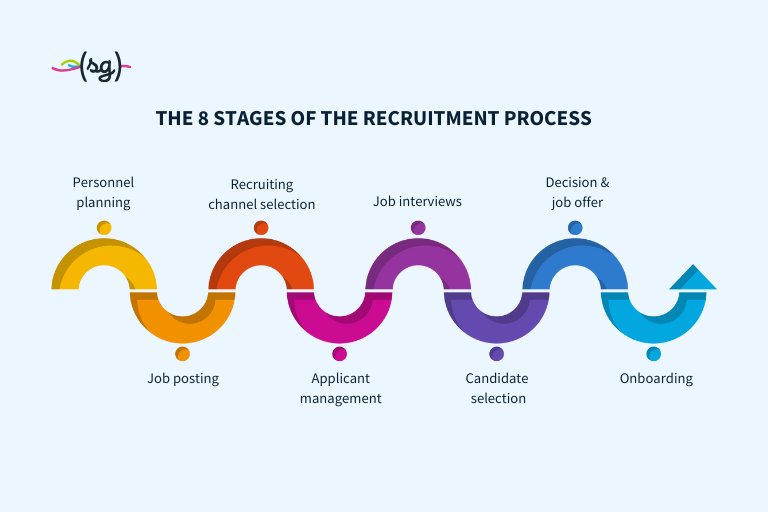Imagine your team is an orchestra … and you’re still missing the perfect violin to complete the sound. This is what recruitment is all about: finding the missing instruments, i.e. the right talent to lead your company to success. But how do you find the right people in times of social media, a shortage of skilled workers and constantly new technologies?
In this article, we give you answers to all these questions. With the right strategy, a pinch of creativity and a good dose of people skills, your company will become irresistible to top talent.
Contents
Recruitment definition: What is recruiting actually?
Recruitment encompasses all measures that a company undertakes to find potential new employees and, ideally, to hire them.
The aim of recruiting is to attract the best talent in order to ensure the company’s long-term success. It is not just about filling vacancies as quickly as possible, but also finding the right candidates with the right qualifications, experience and desired personality. A structured recruiting process is particularly important here.
Recruitment process: The 8 stages of recruiting
A successful recruitment process is usually divided into several phases:

1. Personnel planning
The first step is to analyze personnel requirements: Which positions need to be filled? What qualifications and experience are required? Personnel planning creates the basis for the objectives and selection strategies in recruiting.
2. Job posting
The job posting is created based on a well-founded job description. This should address the target group directly and contain relevant keywords in order to maximize visibility in online job exchanges.
3. Selection of recruiting channels
The right channels are crucial for attracting the right talent. In addition to job portals, platforms such as LinkedIn and Instagram are becoming increasingly important. Active sourcing, employee referral programs and career fairs are also effective options.
4. Applicant management
Incoming applications must be viewed and evaluated in a structured manner. Applicant management systems offer transparency and support fast and coordinated processing.
5. Job interviews
Suitable candidates are invited to interviews. The aim is for both sides to get to know each other in order to check whether there is a personal and professional fit.
6. Candidate selection
Various applicant selection procedures such as assessment centers or personality tests can be used to examine the suitability of candidates for the respective position in more detail during the employee selection process.
7. Decision and job offer
Once the selection process has been completed, a decision is made in favor of one candidate. A job offer is made to this candidate.
8. Onboarding
Once the employment contract has been signed, the onboarding phase begins. The aim is to quickly integrate new employees into the corporate culture and enable them to get off to a smooth start.
Digital recruitment processes for greater efficiency and transparency
Companies that already rely on digital HR processes are experiencing measurable success in filling vacancies: they attract more qualified applicants, conduct more targeted interviews and fill open positions in less time. They benefit from a structured, data-based approach that optimizes the entire recruiting process.
Digital recruiting tools offer numerous functions that support companies in managing their tasks. Applications can be recorded, analyzed and managed centrally so that recruiters can maintain an overview and have all relevant information available in one place.
With the help of applicant management systems, HR teams can view the status of each application at any time, respond quickly to applicant questions and send automated updates to candidates.
This transparency in the recruitment process promotes a positive candidate experience and reduces the likelihood of qualified applicants dropping out.
The digitalization of recruiting processes also helps companies to reduce costs and use resources more efficiently. The use of digital tools such as video interviews and automated assessment systems not only saves time, but also reduces the time and effort required for administrative tasks.
You can find out how you can easily digitalize your recruiting with softgarden on our topic page Digitalization in recruiting.
Recruiting activities: What recruiting channels are there?
Companies can use a variety of recruiting channels to reach potential candidates. A basic distinction is made between internal and external recruiting.
Internal recruitment
In internal recruitment, vacancies are initially filled with employees from within the company. This can be done through internal job advertisements, transfers or promotions. Internal recruiting offers many advantages:
- Lower costs: Internal recruiting is generally more cost-effective than external recruiting.
- Faster recruitment: As internal applicants are already familiar with the company, vacancies can often be filled more quickly.
- Higher motivation and loyalty: Internal applicants are often more motivated and loyal than external applicants.
- Promotion of employee development: Internal recruiting offers employees the opportunity to develop within the company.
External recruitment
External recruitment is chosen when internal appointments are not an option. External recruiting enables a broad selection of potential candidates and often brings a breath of fresh air into the corporate culture.
Possible channels for external recruitment:
Job boards
Online job boards are still an important channel in recruitment. Companies can publish their job advertisements on platforms such as StepStone, Indeed or Monster and thus reach a large number of potential candidates.
Social media recruiting
Social media platforms such as LinkedIn, Xing and Instagram are becoming increasingly important in recruiting. Companies can place their job advertisements on these platforms, create company profiles and present themselves as an attractive employer in order to get in touch with potential candidates.
Active Sourcing
With active sourcing, companies actively search for suitable candidates instead of waiting for applications to come in. Recruiters use special search engines, social media platforms or databases to identify potential candidates and contact them directly.
Google Ads Recruiting
Google Ads Recruiting makes recruitment even more effective. Instead of waiting passively for applications, companies place advertisements directly in Google’s search results. In this way, potential candidates who are actively looking for new challenges are targeted – even if they have not actively applied. Through precise target group definition and appealing ad content, Google Ads Recruiting increases visibility among the desired candidates and generates high-quality applications.
Talent pools
Talent pools allow companies to build up a pool of qualified candidates who have previously expressed an interest. When a vacancy arises, recruiters can access their talent pool and contact suitable candidates directly. This saves time and resources and makes it possible to fill vacancies more quickly.
Talent pools allow companies to build up a pool of qualified candidates who have previously expressed an interest. When a vacancy arises, recruiters can access their talent pool and contact suitable candidates directly. This saves time and resources and makes it possible to fill vacancies more quickly.
Employee referrals
Employee referrals are an effective and cost-efficient recruiting measure. Employees often know the company and the requirements of the vacancies very well and can therefore specifically recommend people from their network who are a good fit for the company.
University marketing
In order to attract young talent, many companies engage in university marketing. They present themselves at careers fairs, organize workshops or offer internships and theses to attract the attention of students and graduates.
Recruiting trends: What’s new?
The job market is constantly changing. New technologies, changing candidate needs and growing competition for the best employees are forcing companies to continuously optimize their recruiting strategies.
The most important trends in recruiting include:
Digitization and automation
Digitization has found its way into recruitment. Companies are increasingly relying on digital tools and processes to make the recruiting process simpler, faster and more efficient.
- E-recruiting: Online applications, digital applicant management systems and video interviews are now standard in recruiting.
- Social recruiting: Social media platforms are becoming increasingly important for reaching and interacting with potential candidates.
- Mobile recruiting: More and more candidates are using their smartphones to find out about and apply for jobs. Companies must therefore ensure that their job advertisements and career websites are also optimally displayed on mobile devices.
- Big data and analytics: By analyzing large amounts of data, companies can gain valuable insights into the behavior of candidates and optimize their recruiting strategies.
- AI Recrutement: AI in recruiting can help companies to screen applications, pre-sort candidates and conduct interviews.
Candidate Experience
Companies must ensure that candidates have a positive experience throughout the entire recruitment process – from the initial contact to the signing of the contract. A positive candidate experience leads to more qualified applications, reduces the drop-out rate in the application process and strengthens the company’s image as an attractive employer.
Employer branding
Employer branding describes how a company positions itself as an attractive employer. The aim is to communicate the company’s values, culture and working conditions to the outside world and thus inspire potential candidates. Strong employer branding is essential in recruiting because it helps companies to stand out from the competition and attract the best talent.
Performance Recruiting
Performance Recruiting focuses on speed, efficiency and convenience in recruiting. Companies use lean processes, automated workflows and data-based decisions to optimize the recruiting process and reduce the time it takes to fill a vacancy.
Conclusion
Recruiting is a dynamic area that constantly presents companies with new challenges. To be successful in the competition for the best talent, companies must constantly adapt their strategies to current trends and developments.
It is crucial to keep the needs and expectations of applicants in focus. A positive candidate experience is a key factor in sustainably attracting qualified talent and thus ensuring the long-term success of the company.
FAQ – Recruitment
Recruiting is concerned with the recruitment of personnel. This means looking for, finding and recruiting new employees for a company.
Recruiting covers all phases of recruitment, from personnel planning, job advertisements and applicant management through to the onboarding of new employees.
Human resources, or HR for short, is often used as an umbrella term for a company’s human resources department. Recruitment is a sub-division of HR and focuses on recruiting new employees.
Yes, recruitment and recruiting are synonyms and refer to the same process.
There is a variety of recruiting measures, e.g. job advertisements on job boards, social media recruiting, active sourcing, employee referrals or university marketing.
E-recruiting offers many benefits, such as greater reach, faster processes, lower costs and a better candidate experience.



